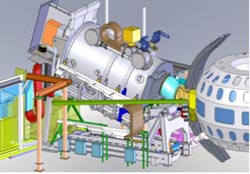Feeling the heat: 30 tons of fine control for fusion plasmas

This is a design drawing showing bus-sized beam injector tilted upward relative to the DIII-D tokamak chamber on the left. Credit: Richard J. Buttery and M.R. Wade, General Atomics<br>
A major upgrade to the DIII-D tokamak fusion reactor operated by General Atomics in San Diego will enable it to develop fusion plasmas that can burn indefinitely.
Researchers installed a movable, 30-ton particle-beam heating system that drives electric current over a broad cross section of the magnetically confined plasma inside the reactor's vacuum vessel. Precise aiming of this beamline allows scientists to vary the spatial distribution of the plasma current to maintain optimal conditions for sustaining the high temperature plasmas needed for fusion energy production.
“The ability to systematically adjust the aiming of such a particle beam to control the shape of the current profile is unique to DIII-D among the world's tokamak experi-ments,” says Dr. Mickey Wade, Director of Experimental Science for the project. “It provides a timely opportunity for testing and improving our understanding of how internal current and pressure profiles will interact as future burning plasma experiments such as ITER approach steady-state conditions.”
The capability to tailor the shape of the current profile is important for maximizing the energy content of the plasma while minimizing the power needed to maintain the large toroidal current that's key to achieving magnetic confinement. Using the beam to broaden the distribution of current across the plasma strengthens the magnetic field structure to support higher plasma pressures. This, in turn, leads to a self-driven “bootstrap” current* which effectively multiplies the original current drive, reducing the need for other external current sources. The will allow the DIII-D team to study the physics of fully self-sustaining plasmas to guide design and operation of future fusion experiments such as the ITER tokamak now under construction in France.
“The project was an enormous challenge, tilting a 30 ton high voltage beam system so that it can be injected at different angles into the plasma with millimeter accuracy,” said Tim Scoville, Neutral Beam Systems Manager. “The beam system is nearly as large as the tokamak!”
Physics studies with the newly modified beam have begun, and the system has already been used to make a broader current profile than was previously possible.
“This represents a major step in DIII-D's capability for developing advanced 'steady state' fusion plasmas,” said David Hill, DIII-D Deputy Program Director.
The 12 month, $7 million upgrade was completed on time, with the new system commissioned during the latest DIII D cam¬paign. The particle beam upgrade forms part of a larger package of developments underway at the facility, with increases in microwave electron heating to access more burning plasma relevant regimes, and new tools being implemented to develop materials and explore how to handle the hot plasma exhaust.
This work supported by U.S. Department of Energy under DE-FC02-04ER54698.
Media Contact
More Information:
http://www.aps.orgAll latest news from the category: Physics and Astronomy
This area deals with the fundamental laws and building blocks of nature and how they interact, the properties and the behavior of matter, and research into space and time and their structures.
innovations-report provides in-depth reports and articles on subjects such as astrophysics, laser technologies, nuclear, quantum, particle and solid-state physics, nanotechnologies, planetary research and findings (Mars, Venus) and developments related to the Hubble Telescope.
Newest articles

Superradiant atoms could push the boundaries of how precisely time can be measured
Superradiant atoms can help us measure time more precisely than ever. In a new study, researchers from the University of Copenhagen present a new method for measuring the time interval,…

Ion thermoelectric conversion devices for near room temperature
The electrode sheet of the thermoelectric device consists of ionic hydrogel, which is sandwiched between the electrodes to form, and the Prussian blue on the electrode undergoes a redox reaction…

Zap Energy achieves 37-million-degree temperatures in a compact device
New publication reports record electron temperatures for a small-scale, sheared-flow-stabilized Z-pinch fusion device. In the nine decades since humans first produced fusion reactions, only a few fusion technologies have demonstrated…





















